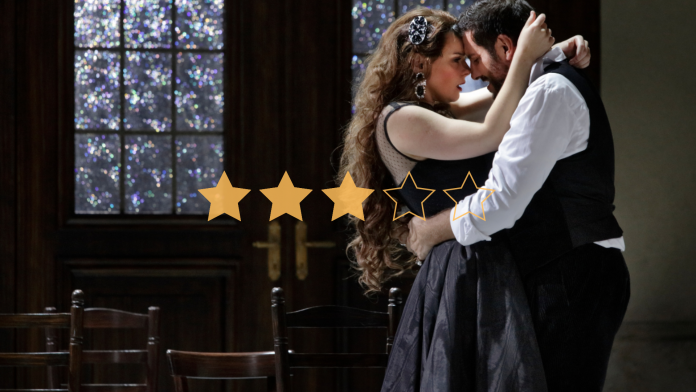
★★★✰✰
In theory, Tosca is a safe bet to start a new season. It has the DNA of a classic opera: lustful love triangles, macabre murder, and snappy melodrama. But even the safest bets carry risk, and the ENO’s bet has not paid off. With a production too afraid to take any gambles, the new season is off to a vanilla start.
Most of the issues stem from prioritising aesthetics; the set is conventional with plain white backdrops and monochrome tiled floor. Scarpia’s scarlet cloak and the occasional drop of blood are the snippets of red that slice through the monochrome. The austerity sets the stage for bold directorial choices to fill the space, but Christof Loy’s clunky direction doesn’t step up to the plate.
Take the moment where Tosca perches in front of an empty golden frame whilst Cavaradossi declares his undying love for her. Visually arresting, yes, but scratch beyond the surface and everything becomes obfuscated. Is she trapped by the frame, objectified by Cavaradossi’s artistic gaze? Or is her beauty so phantasmagorical that she can only exist as art?
The costume design is equally guilty of this blurry artistic vision. Cavaradossi is dressed like a waiter in a tight black waist coat and white shirt (then again, he is an artist, so may well need a night job to pay the bills) but Scarpia seems to have fallen through a time machine followed by pale faced goons in regency wigs, bicorn hats, and Marie Antionette dresses. It is probably meant to signal the marauding Napoleonic invasion of Rome, but it doesn’t hammer the idea home enough to add anything over and above visuals.
The opera is set in Rome in 1800 but you wouldn’t think it from the production. In fact, this production doesn’t seem to be set anywhere in particular; the programme declares profoundly the story’s timelessness but is that not something best left to the audience to infer for themselves? Here it feels like an excuse for unfocused direction and hesitancy to commit to anything specific.
But strong performances save the day. Sinéad Campbell-Wallace has a rich sweetness and a sturdy on-stage presence as Tosca. Despite a concrete vocal performance, Adam Smith’s Cavaradossi is initially unsure of himself gesticulating awkwardly, but he is soon energised by Campbell-Wallace’s Tosca, finding his feet in Act 2.
Due to illness, Roland Wood covers Scarpia with the original Noel Bouley miming the role from the stage. Hats off to Wood, whose voice is confident, rich, and smooth like polished wood.
Bouley holds sway over the stage making for a devilishly delightful confrontation between Scarpia and Tosca in Act 2. They are aided by conductor Leo Hussain who keeps the score tight and edgy with a sprightly tempo that accentuates the hot-blooded histrionics.
Whilst the season may be open to a vanilla start, the ENO’s season promises plenty of flavours. From criminally underperformed operas to critically acclaimed productions, perhaps the ENO are hedging their bets.
Words by Alexander Cohen
Support The Indiependent
We’re trying to raise £200 a month to help cover our operational costs. This includes our ‘Writer of the Month’ awards, where we recognise the amazing work produced by our contributor team. If you’ve enjoyed reading our site, we’d really appreciate it if you could donate to The Indiependent. Whether you can give £1 or £10, you’d be making a huge difference to our small team.